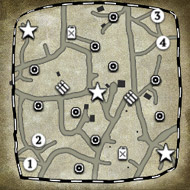I will happily start the reply and doubtless others will correct me and carry on, hopefully. ( I write from a primarily British perspective)
Background
The RAF were split into
- Fighter Command
- Bomber Command
- Coastal Command
- Transport Operations
http://www.raf.mod.uk/rafcms/mediafiles/F21D57C4_9913_5321_BB9830F0BB762B4E.pdf
The Commonwealth Airforce in Normandy was the 2nd Tactical Air Force - the bombers, fighters and ground attack aircraft, who primarily went after the Axis columns and emplacements. (page 144 onwards of the link).
The USAAF can be found here
http://en.wikipedia.org/wiki/United_States_Strategic_Air_Forces_in_Europe
and here
http://en.wikipedia.org/wiki/Eighth_Air_Force
For the purposes of your discussion, both need expanding.
The Normandy invasion
It was an important feature of the Normandy invasion that the region be isolated, so that the Axis could not quickly reinforce with Panzers and other
materiel . Bomber Command, led by "Bomber" Harris, were therefore prevailed upon to attack railway marshalling yards, and transport infrastructure. This was a two-edged sword: the more successful Bomber Command was in cutting the links, the more it hampered the logistics in any break-out from Normandy.
At this point, it may help if I briefly describe the situation in the RAF, by D-Day. Bomber Command was in the ascendancy - it was led by Air Marshal Arthur "Bomber" Harris, a strong personality, who appears to have had the conviction that Germany could be bombed into submission. You will see his bomber group leaders described as "Bomber Barons". Therefore, Harris had to be strongly persuaded that he should divert his bombers to Normandy, and in practice, he could not wait to re-divert his bombers back onto targets in Germany. For him, Normandy was almost a side-show. He did not reagrd his bombers as 'flying artillery'.
In general terms, RAF Bomber Command tried to do what was asked of them: the links were attacked, albeit some coast defences were not hit - the invading troops suffered for that. There is sufficient evidence to suggest that German re-supply was not badly hit, provided they travelled at night. Harris busied himself with Germany again, as soon as he could.
The 2nd Tactical Air Force, which was outside Harris' ambit, set to work in Normandy on tactical targets.
Occasionally. Bomber Command was called back - the prime examples being first, Caen and then Falaise.
Csen took the hit for France. It was supposed to be captured early after D-Day, but it was not. It became a centre for Axis resistance, (together with the nearby Carpiquet airfield). Bomber Command was therefore called in to flatten the city, which it did. But it had the same results as Monte Cassino - a flattened city does not help invading troops. The ruins provide defence points, which are difficult to spot, so you have to call in valuable engineers to clear a path through the rubble. At the same time, the infrastructure breaks down, which has to be repaired, and the survivors (who need feeding and medical care) are at risk of disease, which can spread to the troops.
You do not read much about French cities being obliterated after Caen - the Allies had learnt their lesson. Caen bled for France.
As for logistics, the aircraft for the paratroopers was the c-47 Dakota, and these were mostly manned by USAAF.
As for the provision of gas/oil, this was provided by pipeline from Southern England - PLUTO .
http://www.combinedops.com/pluto.htm









 Thank you for facilitating the discussion! MajBloodnok adds some great information, I was aware of the man made Mulberry harbour, but not PLUTO, very cool!
Thank you for facilitating the discussion! MajBloodnok adds some great information, I was aware of the man made Mulberry harbour, but not PLUTO, very cool!
















 cblanco ★
cblanco ★  보드카 중대
보드카 중대  VonManteuffel
VonManteuffel  Heartless Jäger
Heartless Jäger 